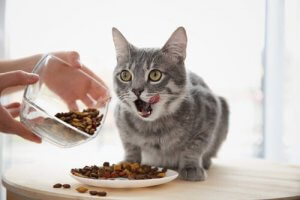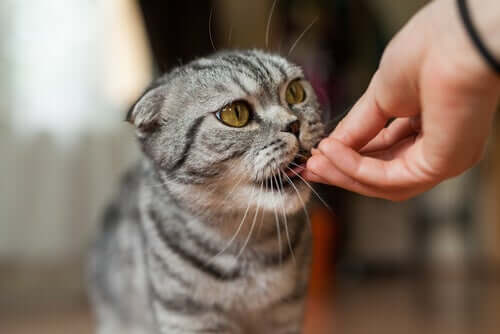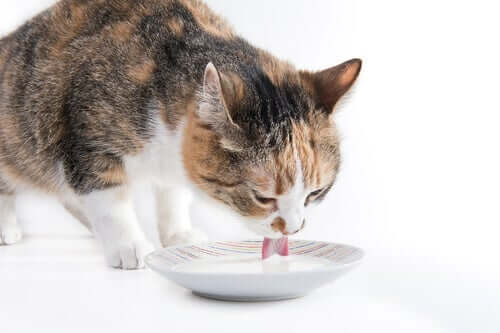All About the Feline Digestive System

A cat’s body contains different systems, like the digestive system, which work together with other organs from other systems. In this way, the organism can stay healthy and carry out its vital functions. Today we’ll take a detailed look at the feline digestive system.
What’s the digestive system?
The digestive system consists of a set of organs that are responsible for processing and breaking down foods and liquids. Afterwards, the body uses these substances as a source of energy, for growth, and for tissue repair.
Substances that are not processed turn into waste. Then, the body eliminates this waste, which it has no use for, via bowel movements.
Components of the feline digestive system
The feline digestive system consists of the following components:
- Mouth
- Pharynx (throat)
- Esophagus
- Stomach
- Small intestine
- Large intestine
- Rectum
- Anus

The feline digestive system also includes the saliva glands, the gallbladder, and the pancreas. Its function is to produce enzymes and digestive juices that facilitate the absorption of nutrients and liquids.
The functioning of the digestive system
Breaking down ingested foods to obtain and assimilate nutrients is the main function of the feline digestive system. The process of digestion starts in the mouth, with the secretion of saliva. Saliva serves to add moisture to foods, making this step easier. The alpha-amylase enzyme, which begins the process of decomposition, is not present in cats or in dogs.
Swallowing
Once that a ball of food and saliva has formed, it moves down the cat’s throat. Here, pharyngeal contractions take place to transport the food.
The epiglottis blocks the trachea, keeping food from getting into the cat’s lungs. Meanwhile, contractions move the food on to the esophagus.
If the first peristaltic movement doesn’t manage to impulse the food and liquids to the stomach, a second movement takes place. In cats, the speed of swallowing liquids between 0.5 and 1 inch per second.
Therefore, when administering pills orally without water, you need to be very careful. This is because of the risk of pills remaining in the esophagus, leading to the development of esophagitis.

Stomach
In cats, the stomach is located on the left side of the body and consists of 5 different parts. Its main function is to secrete chlorhydric acid and pepsinogen which, along with the enzymes, facilitate the digestion of foods.
The most important digestive enzymes are pepsin and lipase. Pepsin acts when pH is 2.0 and “cuts” proteins into smaller units, called peptides.
Pepsin digests meat proteins better than vegetable proteins. Therefore, it’s more important in dogs than in cats, as dogs tend to ingest more meat that cats do.
At the same time, gastric lipase is an enzyme that’s responsible for breaking down long-chain fatty acids. Its function is less important than that of pancreatic lipase.
Cats ingest a smaller quantity of food than dogs, but at a greater frequency throughout the day. In other words, dogs eat fewer times per day, but in larger quantities.
The small intestine and the pancreas
The small intestines of cats are about 4 feet, 3 inches long and consist of 3 areas. These are the duodenum, the jejunum and the ileum. This is where the majority of enzymatic digestion of food takes place. In cats, this lasts between two or three hours.
The surface of the small intestine has different modifications that allow it to widen its area of absorption. An example is the microvilli of the luminal surface.
The small intestine has enzymes that allow for the digestion of disaccharides, oligosaccharides, and small-sized peptides. There are also proteins that transport important substances like calcium and iron.
The mucus layer of the intestine as a protective coating from pathogenic agents. However, it can become atrophied as a result of the use of some medications or a lack of vitamin B12 (cobalamin) or folates.
The pancreas secretes enzymes that are essential for the breaking down of carbohydrates, proteins, and lipids. Normally, it secretes inactive precursors of these enzymes, like trypsin, which activate and act inside the small intestine.
The large intestine
The large intestine consists of the colon, the caeca, and the rectum. In adult cats, it reaches a length of 1 foot, 4 inches. Its main function is the absorption of electrolytes and water.
What’s more, it’s worth pointing out that the large intestine is in charge of fermenting non-absorbed nutrients. Hence, transit in the large intestine is slower.
The last step in the digestive process is the elimination of all waste that the body cannot use.
Curiosities of the feline digestive system
Several different factors affect the enzymes of the microvilli. These include age, diet, and different illnesses. An example of this is the decrease in lactase.

Lactase is an enzyme that digests lactose, a disaccharide of milk. As this enzyme decreases, adult cats cannot tolerate milk as well as kittens.
Other circumstances that change the large intestine are dietary changes, as enzymes take one or two days to adjust to these changes. Therefore, there may be an increase in undigested carbohydrates. This, in turn, can lead to enteritis and manifest itself as diarrhea.
Taking care to provide proper nutrition for your cat will assure that its digestive system works correctly and that your pet is happy and healthy.
A cat’s body contains different systems, like the digestive system, which work together with other organs from other systems. In this way, the organism can stay healthy and carry out its vital functions. Today we’ll take a detailed look at the feline digestive system.
What’s the digestive system?
The digestive system consists of a set of organs that are responsible for processing and breaking down foods and liquids. Afterwards, the body uses these substances as a source of energy, for growth, and for tissue repair.
Substances that are not processed turn into waste. Then, the body eliminates this waste, which it has no use for, via bowel movements.
Components of the feline digestive system
The feline digestive system consists of the following components:
- Mouth
- Pharynx (throat)
- Esophagus
- Stomach
- Small intestine
- Large intestine
- Rectum
- Anus

The feline digestive system also includes the saliva glands, the gallbladder, and the pancreas. Its function is to produce enzymes and digestive juices that facilitate the absorption of nutrients and liquids.
The functioning of the digestive system
Breaking down ingested foods to obtain and assimilate nutrients is the main function of the feline digestive system. The process of digestion starts in the mouth, with the secretion of saliva. Saliva serves to add moisture to foods, making this step easier. The alpha-amylase enzyme, which begins the process of decomposition, is not present in cats or in dogs.
Swallowing
Once that a ball of food and saliva has formed, it moves down the cat’s throat. Here, pharyngeal contractions take place to transport the food.
The epiglottis blocks the trachea, keeping food from getting into the cat’s lungs. Meanwhile, contractions move the food on to the esophagus.
If the first peristaltic movement doesn’t manage to impulse the food and liquids to the stomach, a second movement takes place. In cats, the speed of swallowing liquids between 0.5 and 1 inch per second.
Therefore, when administering pills orally without water, you need to be very careful. This is because of the risk of pills remaining in the esophagus, leading to the development of esophagitis.

Stomach
In cats, the stomach is located on the left side of the body and consists of 5 different parts. Its main function is to secrete chlorhydric acid and pepsinogen which, along with the enzymes, facilitate the digestion of foods.
The most important digestive enzymes are pepsin and lipase. Pepsin acts when pH is 2.0 and “cuts” proteins into smaller units, called peptides.
Pepsin digests meat proteins better than vegetable proteins. Therefore, it’s more important in dogs than in cats, as dogs tend to ingest more meat that cats do.
At the same time, gastric lipase is an enzyme that’s responsible for breaking down long-chain fatty acids. Its function is less important than that of pancreatic lipase.
Cats ingest a smaller quantity of food than dogs, but at a greater frequency throughout the day. In other words, dogs eat fewer times per day, but in larger quantities.
The small intestine and the pancreas
The small intestines of cats are about 4 feet, 3 inches long and consist of 3 areas. These are the duodenum, the jejunum and the ileum. This is where the majority of enzymatic digestion of food takes place. In cats, this lasts between two or three hours.
The surface of the small intestine has different modifications that allow it to widen its area of absorption. An example is the microvilli of the luminal surface.
The small intestine has enzymes that allow for the digestion of disaccharides, oligosaccharides, and small-sized peptides. There are also proteins that transport important substances like calcium and iron.
The mucus layer of the intestine as a protective coating from pathogenic agents. However, it can become atrophied as a result of the use of some medications or a lack of vitamin B12 (cobalamin) or folates.
The pancreas secretes enzymes that are essential for the breaking down of carbohydrates, proteins, and lipids. Normally, it secretes inactive precursors of these enzymes, like trypsin, which activate and act inside the small intestine.
The large intestine
The large intestine consists of the colon, the caeca, and the rectum. In adult cats, it reaches a length of 1 foot, 4 inches. Its main function is the absorption of electrolytes and water.
What’s more, it’s worth pointing out that the large intestine is in charge of fermenting non-absorbed nutrients. Hence, transit in the large intestine is slower.
The last step in the digestive process is the elimination of all waste that the body cannot use.
Curiosities of the feline digestive system
Several different factors affect the enzymes of the microvilli. These include age, diet, and different illnesses. An example of this is the decrease in lactase.

Lactase is an enzyme that digests lactose, a disaccharide of milk. As this enzyme decreases, adult cats cannot tolerate milk as well as kittens.
Other circumstances that change the large intestine are dietary changes, as enzymes take one or two days to adjust to these changes. Therefore, there may be an increase in undigested carbohydrates. This, in turn, can lead to enteritis and manifest itself as diarrhea.
Taking care to provide proper nutrition for your cat will assure that its digestive system works correctly and that your pet is happy and healthy.
All cited sources were thoroughly reviewed by our team to ensure their quality, reliability, currency, and validity. The bibliography of this article was considered reliable and of academic or scientific accuracy.
-
Exploración clínica de animales domésticos (caballo, vaca, perro y gato): prácticas de propedéutica clínica. Univ. Autònoma de Barcelona; 2006. 172 p.
-
HVC. El aparato digestivo en perros y gatos [Internet]. Hospital Veterinari de Catalunya. 2016 [citado 4 de agosto de 2019]. Disponible en: https://hvc.cat/es/el-aparato-digestivo-en-perros-y-gatos/
-
Marge Chandler. FISIOLOGÍA GASTROINTESTINAL DEL PERRO Y EL GATO. Advance Veterinary Diets Affinity [Internet]. Disponible en: https://vetsandclinics.affinity-petcare.com/hubfs/Content/GUIA_GI_Parte1.pdf?t=1480667974633
- Osorio, J. H., & Cañas, E. Z. (2012). METABOLIC BASES IN FELIS CATUS LINNAEUS, 1758 (CARNIVORA: FELIDAE). Boletín Científico. Centro de Museos. Museo de Historia Natural, 16(1), 233-244.
This text is provided for informational purposes only and does not replace consultation with a professional. If in doubt, consult your specialist.








